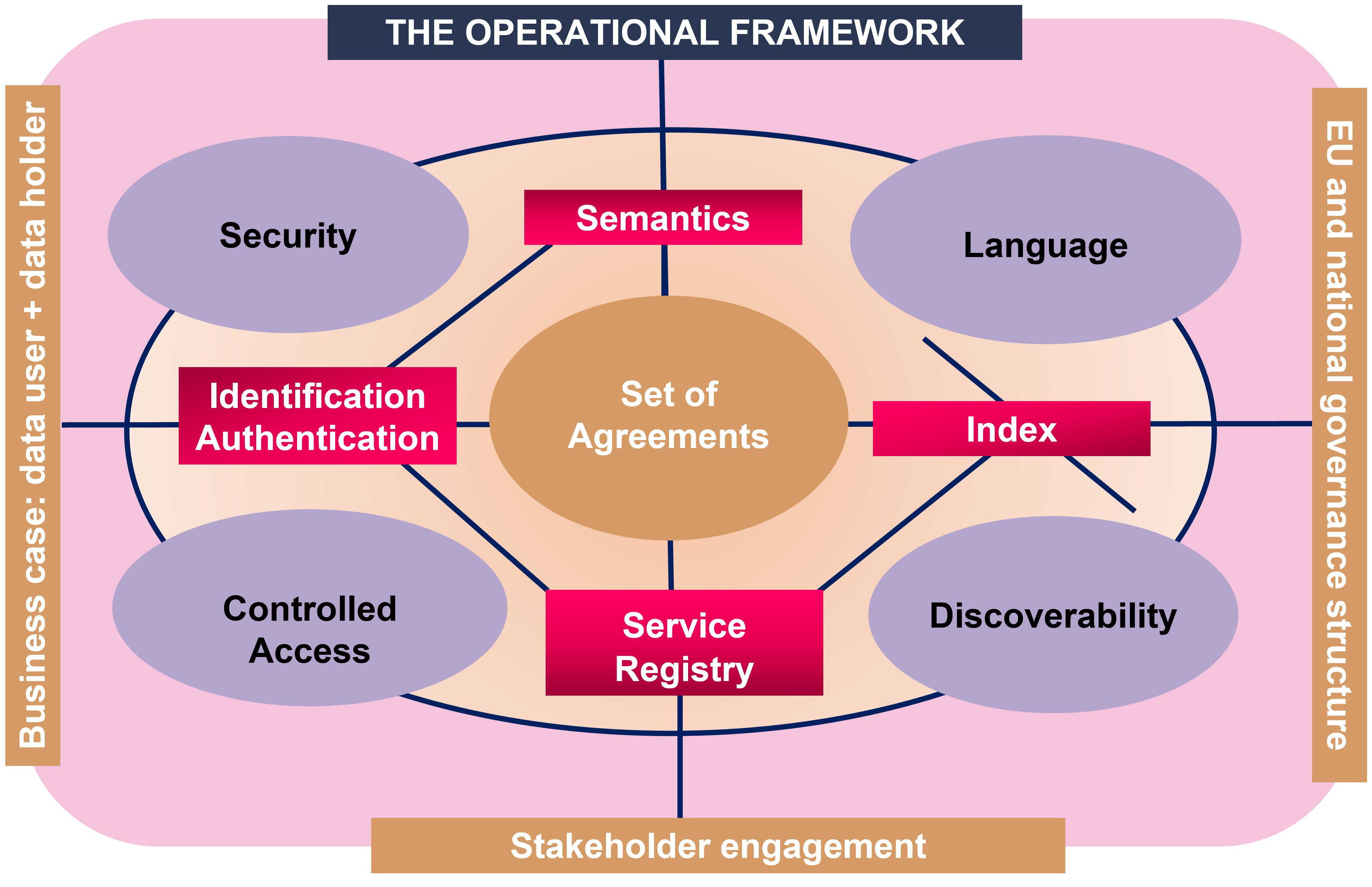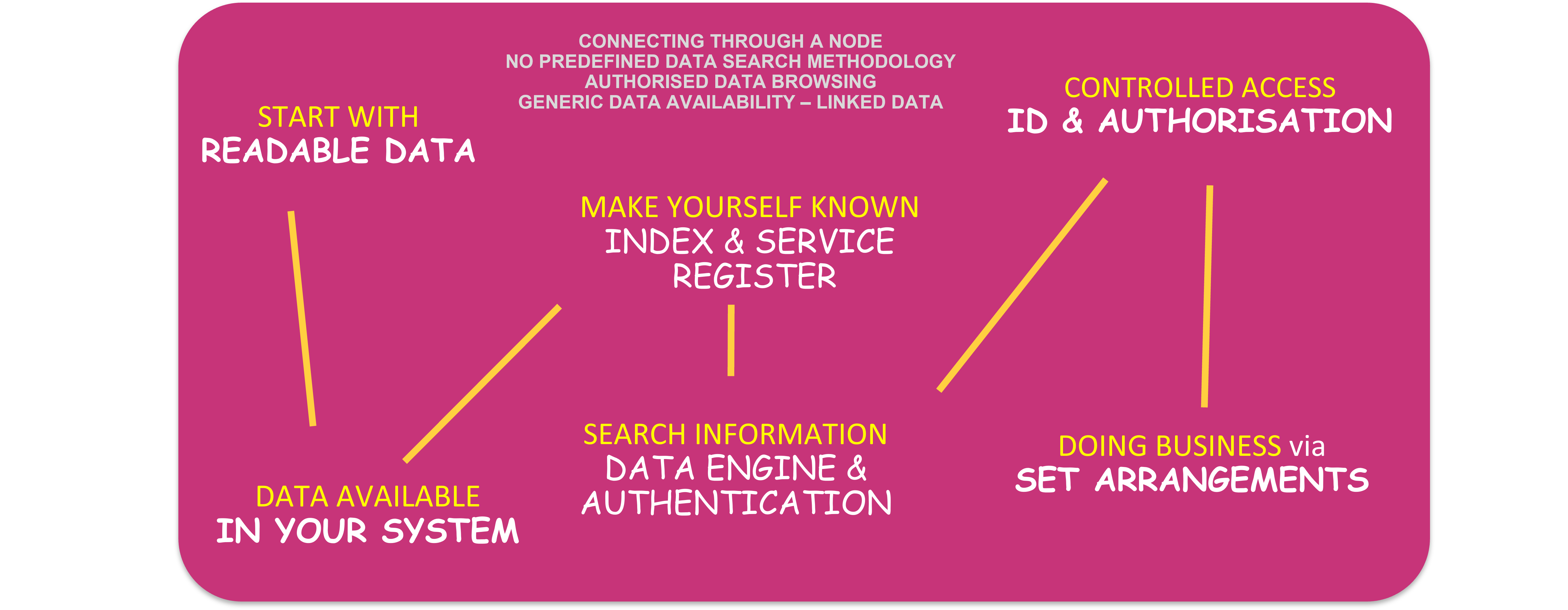The FEDeRATED proposition
FEDeRATED proposes an EU federated network of platforms – data sharing grid – for logistics (EU Mobility Data Space). This is an interoperable network of virtual worlds based on digital twins and connecting Events that can be accessed at the same time by millions of users, who can exert property rights over virtual items. Data holders and data user can meet and conduct business. Security and scaling are essential. Ecosystems must be interoperable, connected through the functional requirements and technical specifications of the data sharing grid. The organisational requirements set the terms for login, registration and certification safeguarding interoperability.
The urge is for EU collaboration between companies and public authorities towards devising and adopting open standards. The market that this will unlock will be much bigger than any of them alone could create alone; - a common format creates a bigger market. For various ecosystems already taking shape within the supply chain, it makes economic sense to share data and interoperate. Portability of data or for that matter property rights over virtual items will drive standardisation and interoperability over time.
Using data and providing services to another through a EU data sharing grid - EU Mobility Data Space - would most likely change the way logistic operators experience the internet, with the advent of things like navigation apps, transport monitoring and container and cargo tracking systems, situational awareness and smart mobility Apps also to facilitate eEnforcement, eCustoms and eCompliance.
The FEDeRATED project assists the EC in developing a future proof data sharimng grid.
How to make a FEDeRATED data sharing grid ?

The FEDeRATED project is developing a Masterplan, containing of several requirements and specifications. inclusion of the FEDeRATED functional requirements and technical specifications will empower all participants to connect, either within one ecosystems or platform or between a multitude of platforms or ecosystems. Business can be conducted through a set of arrangements (protocol stack)
The functional requirements of the infrastructure provision - the core requirement is data at source. refer to the need for:
- “Common” language – the semantics and interaction order (process choreography) for data processing by heterogeneous systems or platforms
- Discoverability of data and participants – it is about being able to search and find (query) service providers and data that an organization needs for its tasks. The latter is filled in with 'Linked Data': an organization receives a link to data as an indication of the data they may access.
- Security for all participants - to provide trust for all participants.
- Controlled Access to all participants – enabling any company to give another company or competent authorities access to data that either the company is willing to make available to others or the need to provide in accordance with legislation. This can be done through open data or via links that have been shared. In practice, this access will be limited, thus controlled access. Not everybody will have access to all of each others data
The technical specifications for any data holder or user to participate in the data sharing grid in a FEDeRATED way are:
- Apply the semantic web technology and a common semantic model (Semantic adapter)
- Utilize an Identification and Authentication mechanisms (IA) – the unique identification and authentication of a person and their authority granted by their employer (verification of authorization). AuthoriSation itself is part of procedures of each participating organiSation.
- Apply a Service Registry - allowing for a distributed development of data sharing according to common concepts. This configures a node of a participant meeting its business service/- goals data requirement
- Deploy an Index – providing any participating organisation a transparent overview of the event-based data being available to share for conducting business and administrative compliance procedures
The organisational requirements - the set of agreements enabling organisations to connect based on their capacities - consists of the following implementing protocols (protocol stack):
- Connectivity protocol(s) – the technical capability to enable two protocol stacks to implement reliable data sharing
- Security protocol(s) – the safe and secure sharing of data.
- Presentation protocol(s) – the syntax and technology (messaging, Application Programming Interfaces) used for sharing data.
- Linked Event Data protocol (pull) – sharing of links based on logistics events. It is the interface between two instances of the Index component.
- Business protocol – the functionality of each event in its context for sharing data in various business processes between organisations - specifies a structured set of event types (business process choreography) and their minimal data requirements for providing business services. The business layer implements ‘search’ and pulls data and may pose additional security requirements[1].
- Semantics – the business – and Linked Event Data protocol make use of a common semantics that are interoperable with existing global standards such as WCO, UNCEFACT, IATA and IMO.
These architecture requirements and specifications sum up to enable the participants to become a node in the data sharing grid – EU Mobility Data Space. The Node:
- always interfaces with a Service Registry and can thus always be configured;
- allows each stakeholder to share data independent of any existing platform while implementing an open source;
- fully supports the language, also supports one or multiple options of the protocol stack, i.e. protocols regarding presentation, security, and connectivity like REST APIs usng ‘https’. This also requires a so-called 'semantic adapter'.
These requirements and specifications will be further developed and incorporated into the final FEDeRATED Master Plan. As such they establish an interoperable grid of trusted nodes.
How the federated network of platforms concept would work
The licence to operate for any organisation to act as a node within the grid is based on a set of agreements, they comply with. Based on its technical and semantic abilities this organisation can browse the data sharing grid, and its connected ecosystems. They randomly query – not based on any predefined data search method – generic available linked data. Controlled access, based on agreed Identity, Authentication , and Authorisation mechanisms allow a secure connectivity. An Index is available and used enabling data owners to make data elements available, not sharing duplicated data. A Service Register will help to find the suitable partner accessing not only the data, but also the services. Third parties, not logistic operators can participate providing and developing services. A change management system approach is provided. The governance is distributed on a centralised (EU, important for safeguarding interoperability) and decentralised, local level. The power of pull is advocated.

The EU policy requirements
In order to succesfully develop a federated ata sharing grid a pro active policy approach is required. The policy requirements: than enable the development of a data sharing grid for logistics – EU Mobility Data Space - are
- An overarching EU and national regulatory approach and policy incentives – to support and stimulate data sharing i.e., fostering the EC data spaces policy for logistics in conjunction with cross sectoral data sharing practices. This relates to the need to:
- Define the functional requirements for the data sharing infrastructure provision (the Mobility Data Space for logistics)
- Establish a long-term and transparent data sharing infrastructure framework, thus enabling organisations to invest in digital readiness.
- Enhance the current state of digital competence (readiness) of organisations (companies and public authorities) through dedicated programmes and projects.
- An EU and national governance structure possibly including standardisation and certification. The governance of the federated data sharing grid should preferably:
- Establish and maintain the technical specifications of the data sharing grid, also adjusting it to future developments
- Organize the registration (or certification) of the various organisation that would like to act as a node within the infrastructure provision.
- Monitor the development of the infrastructure provision, thereby also checking the compliance and conduct/performance of the various nodes within the grid.
The effective governance of a federated network of platforms should take into consideration the division of tasks - who must play what role supervising the governance – also within the perspective of distributed governance.
The FEDeRATED project can help to deliver the components such a legislative framework would require. The legislative framework could be identified as a EU Data Mobility Space. For logistics, this could be further developed under the auspices of DTLF.
The reasoning for a legal EU Data Mobility Space framework could be as follows:
- Data available foster seamless multimodal transport, also solving interoperability bottlenecks
- There should be a grid for organizations that share and have access to logistics, supply, and mobility data
- The framework is about participation of an organization in the grid (access)
- The following aspects are relevant: access to, functionality of, and evolution of the grid
- Access to the grid is decomposed into trust of an organization and its behavior
- Trust is about registration and compliance to acts and regulations like GDPR, cyber-security act, data (governance) act, etc. It ensures also that an organization has implemented IAA with access control. The role must be clear: enterprise active in mobility and logistics, authority, R&D institute, platform provider, Value Added Service (VAS) provider
- Behaviour is about implementation of the protocol stack and publication of a profile.
- Implementation of the protocol stack and a profile must be validated (possibly certified).
- Service providers and authorities must provide their profile; customers may provide their profile.
- An authority profile defines the area in which that authority is governing regulations, the moments in time and place that authority needs to be informed, and the access to data that is required
- Organizational profile is supported by the Service Registry.
- The protocol stack is implemented by the participating organizations thus enabling them to register as trusted node in the network.
- A trusted node must at least support one enterprise active in mobility and logistics; in case it supports more than one it is called a ‘platform’
- Existing platforms and ecosystems can participate in the grid by (collectively) acting as trusted node and providing the profiles of their users/members (interoperability with existing data spaces and platforms)
- The functionality of the grid is about the semantic model, including the capability for VAS development by trusted stakeholders
- The functionality of the grid is developed in a distributed way (per modality, cargo type, etc.), but must adhere to agreed rules and procedures (governance)
- The functionality should always be backwards compatible to assure that data is not lost and business processes are not interrupted (governance)
- Each ‘trusted node’ must contain an update mechanism for implementing the functionality of the grid and make this functionality available when published (governance)
- There can be multiple trusted registration authorities. A trusted node has a unique identifier assigned by a registration authority.
- Evolution is about new functionality and innovation in technology providing new possibilities, resulting in major changes of the grid (to be defined)
- Applicability of the framework – it is applicable to mobility and logistics within, into, and out of the EU.
- Hits: 4095
